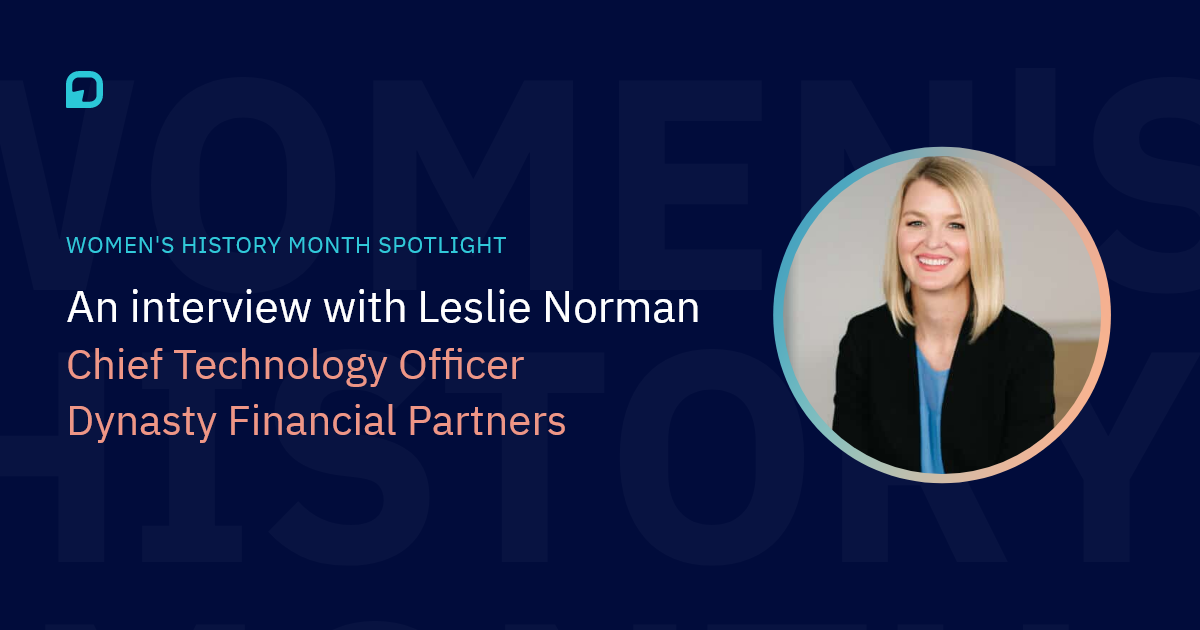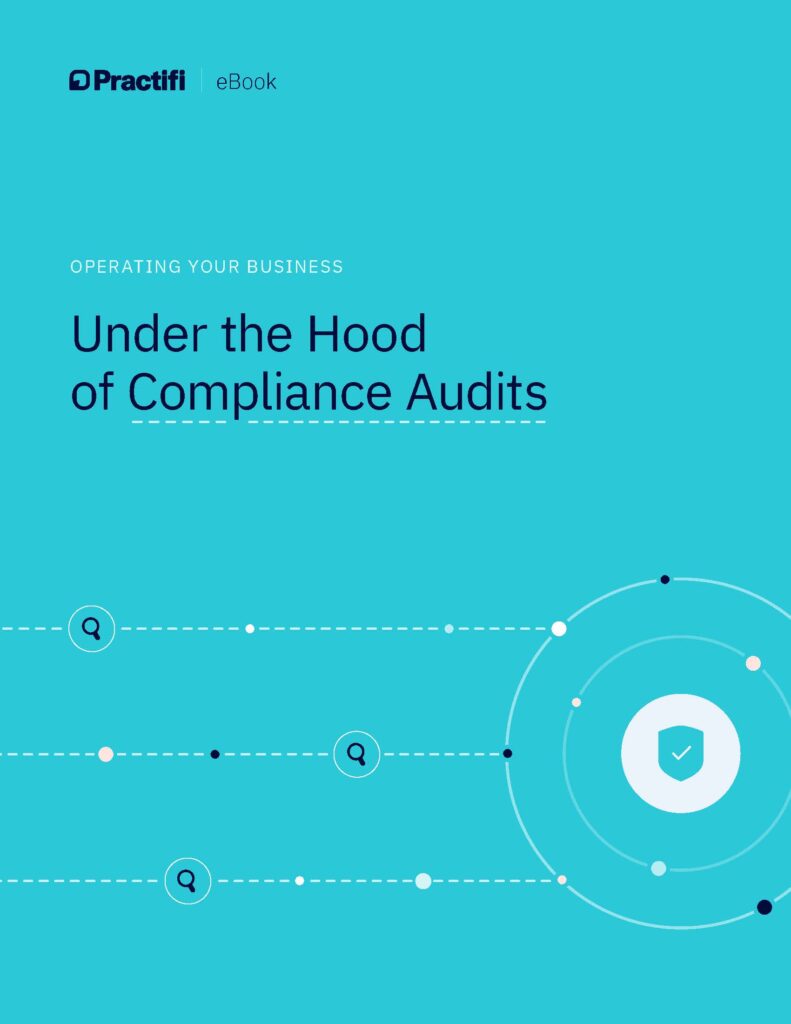
Women’s History Month Spotlight with Leslie Norman

BY Team Practifi
In celebration of Women’s History Month, we are proud to bring back our spotlight series for a second year, highlighting the contributions and journeys of women shaping the wealth management and finance industry. This year, we are honored to feature five remarkable women leaders who have forged their own paths in wealth management technology, driving innovation, advocating for inclusivity and making a lasting impact in this evolving space. Through their stories, we celebrate their achievements, highlight their expertise and share valuable insights from their unique experiences.
Say hello to Leslie Norman, Chief Technology Officer at Dynasty Financial Partners. Leslie’s career journey from finance to technology reflects the power of curiosity, problem-solving and a drive to innovate. With a passion for leveraging technology to create better business outcomes, she has built a career at the intersection of finance, operations and technology leadership. Throughout her career, Leslie has been an advocate for mentorship, diversity and creating pathways for women in financial services.
In this interview, she shares her career journey, insights on the evolving fintech landscape and advice for women looking to advance in the industry.
From Problem-Solver to Industry Leader
Leslie has always been motivated by solving complex problems and finding ways to make businesses run more efficiently. While she started with a degree in finance, it was her exposure to operations and process improvement that led her to discover the impact of technology in financial services. This passion for innovation ultimately shaped her career, leading her to a leadership role in fintech.
Q: Can you share a bit about your background and journey into the wealth management industry?
A: I graduated with my degree in finance, but I quickly realized that finance was not actually my calling. I did not know exactly what I wanted to do with my career, so I moved back home to St. Petersburg, Florida, to do some soul searching. To appease my parents, I took an entry-level job at a financial services firm in my hometown.
While working there, I had early roles in operations, including some work as a process improvement consultant. Through that role, I really learned about how technology can drive better business results. I also discovered that I have a knack for solving complicated problems and that I really enjoy doing that through technology.
Fast forward from that role to now, I have always enjoyed working with financial advisors. In my current role as Chief Technology Officer at Dynasty Financial Partners, I get to do what I love every day — helping our clients build great businesses and take phenomenal care of their own clients.
Q: What would you say your career in this industry was intentional, or did you find yourself here by happenstance?
A: I think my degree in finance is what initially landed me in a financial services setting, but beyond that, my path was more organic. It was not necessarily a prescriptive path that I had planned from day one, but as I gained experience and explored different roles, I discovered where my strengths and interests aligned.
What made me stay in this industry and ultimately take on a leadership role was my motivation to solve complex problems. I found that financial services gave me the opportunity to do that in a meaningful way. From day one, I have worked with financial advisors who serve their clients by helping them achieve their financial goals and, in many cases, realize the American dream. I have always felt a sense of purpose in being part of that process.
Q: What challenges have you faced as a women in financial technology and how did you navigate them?
A: One challenge has been breaking into decision-making circles where women are underrepresented, and that was something I expected coming into this space.
What I did not expect, though, was how differently women in leadership are judged compared to men. I realized early on that women are not only evaluated on their competence but also on how likable they are, which is not always the case for men.
As a result, over the years, I have received a lot of advice on how to be both direct and decisive while also maintaining a level of likability. Part of my journey has been figuring out how to balance being authentic and being effective at the same time.
This has been an important part of my leadership experience, especially as I have navigated spaces where the people around me do not always think or look like me. Finding my way in those circles has required both confidence and adaptability, and it has been a key part of my growth as a lead.
Beyond the Broken Rung and Into the Boardroom
For Leslie, leadership in financial technology has meant navigating an industry where women are still fighting for representation in decision-making roles. While progress has been made, challenges like the broken rung effect continue to hinder advancement. Leslie has seen firsthand how mentorship, sponsorship and company-wide commitment can make a difference. Here, she shares her insights on how the industry is evolving and what firms can do to create real opportunities for women in leadership.
Q: How have you seen the role of women in financial services and technology change over the years?
A: We are seeing some progress in terms of female representation in leadership and decision-making rooms. However, the broken rung effect, as I have heard it referred to, continues to hinder women from reaching top leadership positions.
This is a major challenge in our industry because there is clear evidence showing that diverse perspectives drive innovation. When there are different viewpoints in the room, shaped by unique life experiences, it forces people to question, challenge and approach problems from new angles. That kind of thinking ultimately leads to better business outcomes.
But there is still a long way to go. There is a lot of work left to do in getting women into leadership roles at the rate we should be seeing, not just in financial services but across industries.
Q: Can you explain what you mean by the broken rung effect and how it impacts women in leadership?
A: You have probably heard people refer to climbing the corporate ladder. The broken rung effect is a metaphor for the missing step on that ladder — the first promotion that women often do not receive at the same rate as men.
Because of that missing step, women fall behind early in their careers, and that gap compounds over time, making it harder and harder for them to progress upward into senior leadership roles.
It is not just about one promotion. It is about how each missed opportunity creates long-term setbacks, which is why we still see fewer women at the top despite so much progress in other areas.
Q: Do you think companies have a social responsibility to ensure women know there are opportunties available to them in this industry?
A: Yes, but I think it is deeper than just checking a box. It is not just about saying, “We are committed to hiring more women,” it is about driving awareness and recognition that having diverse perspectives is a competitive advantage. When you have women and other diverse voices shaping company strategy and decision-making, you create stronger, more innovative businesses. It is not just the right thing to do, it makes business sense.
Q: How can companies actively promote and support the advancement of women into leadership positions?
A: It has to be a multi-pronged approach. That means tracking hiring, retention and promotion rates and measuring whether cultural shifts are actually happening within the organization. It also means providing mentorship, sponsorship and flexibility to help women not just enter the industry but stay and grow in it.
At Dynasty, we have a women’s network, which is a great example of how firms can create communities of support for both female employees and clients. But more importantly, it is about advocacy — having a voice in the room who will speak up for you when you are not there. That kind of sponsorship is a critical component of career progression.
Q: How do you think women should approach finding the right mentor to help navigate their careers?
A: I believe that a critical part of a mentorship relationship is trust. Growth and career progression often require an element of vulnerability, and for a mentorship to be truly valuable, you need to feel comfortable having honest conversations with someone who genuinely has your best interests at heart.
It’s important that trust flows in both directions. A great mentor is not just someone who gives advice but someone who helps you see opportunities you might not have recognized on your own.
The Future of Wealth Management and the Women Leading the Way
As Leslie Norman looks ahead, she sees a turning point in financial services. Women are gaining more financial influence than ever before, yet leadership roles still remain out of reach for many. She believes the industry is evolving, but true progress will depend on more women stepping up, speaking out and shaping its future.
Q: How do you see the future of wealth management and technology evolving, particularly for women?
A: I was looking up a stat that I have heard shared before, and it estimates that by 2030, women could control as much as 30 trillion dollars in financial assets in the U.S. alone.
This shift is being driven by wealth transfer, increased earnings, ownership and investment participation. As fintech expands, there is a real opportunity to build platforms that reflect the needs of all investors, not just those who have traditionally been at the center of financial decision-making.
That is why having women in leadership positions is critical. As the market evolves, firms need diverse perspectives at the table to ensure that technology, products and services truly support the changing landscape of investors and wealth holders.
Q: What advice would you give to women entering wealth management?
A: I would say that no matter what position you are in or how long you have been in it, maintaining a learning mindset is critical. Growth comes from continuously learning and applying new knowledge to your work.
Another key piece of advice is to not wait until you feel fully ready to go for a leadership role. We have all seen the data on how women tend to assess their readiness more critically than men do. Often, women will feel they need to meet 100 percent of the qualifications before applying for a position, while some of our male counterparts are comfortable going for it with just 60 percent of the criteria met.
So, my advice is simple: Go for it. Push yourself, take on new challenges and embrace being uncomfortable as you reach for new heights in your career.
The Power of Bold Decisions and Continuous Growth
The most meaningful careers are shaped by bold decisions, continuous learning and the willingness to challenge the status quo. Progress happens when women take ownership of their growth, advocate for their place in leadership and push industries forward.
Leslie’s story is a reminder that great leaders are not just those who succeed, but those who open doors for others. As the financial industry evolves, having diverse voices at the table will be key to building solutions that serve everyone.
Thank you, Leslie, for sharing your experiences and leadership.









